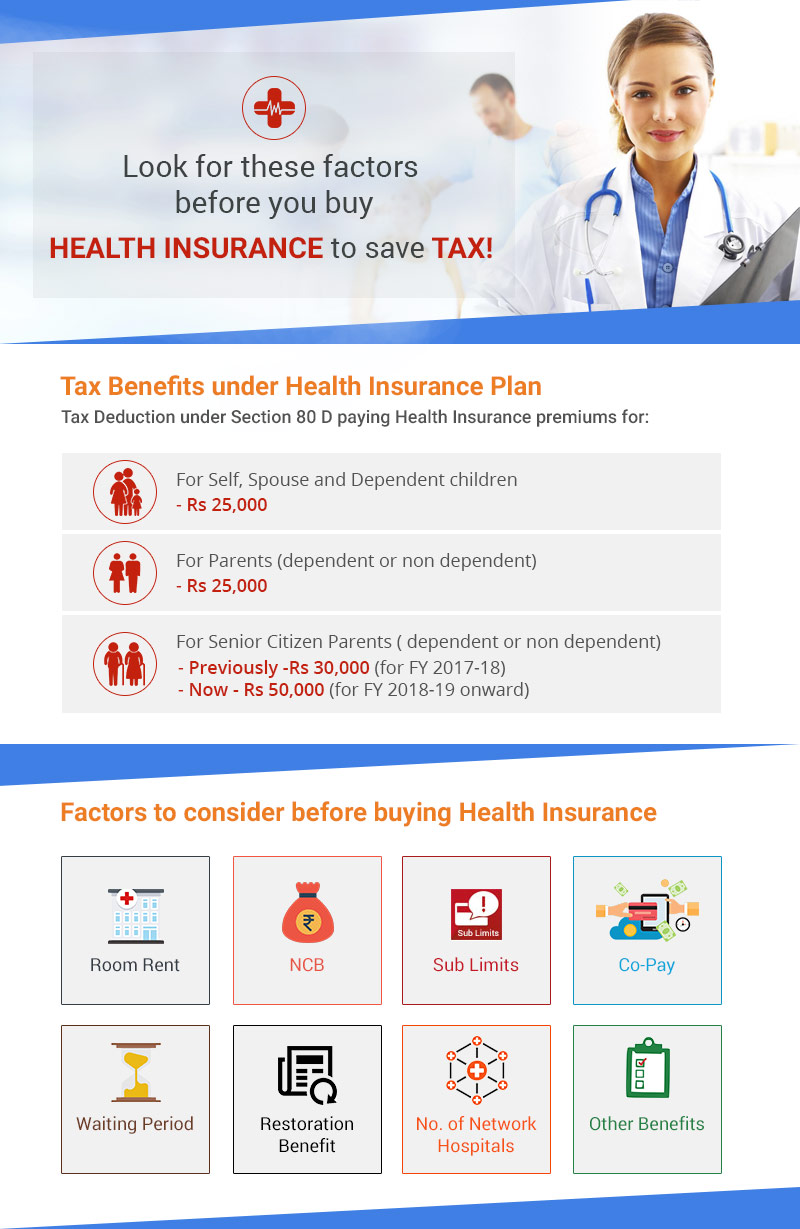Planning to buy a Health Insurance? Watch out for these important factors!
Health Insurance is an essential product to avoid the pocket expenses for health care needs. But when you will look or planning to buy a health insurance plan available in the market, it becomes confusing to shortlist anyone. Also, sometimes you buy a health insurance plan in a hurry to save your tax under section 80D. But, health insurance is an important investment and thus it is imperative not to make a decision in haste. Most important is the health coverage or the sum insured under the plan. Adequate health insurance coverage is the basic fundamental requirement. Don’t fall for cheaper plans which will also offer you a lesser sum insured as it might not be sufficient when it comes to getting a treatment done in your choice of hospital, rising medical inflation, and rising health care costs.
Look for these important factors before you finalize a health insurance plan for yourself:
Table Content
- Room Rent Limits
- Room Rent Benefits under some Health Insurance Plans:
- No Claim Bonus (NCB)
- NCB benefits under some Health Insurance Plans:
- Co-Payment Clause
- Co-payment under some Health Insurance Plans:
- Waiting Period
- Waiting Period’s under some Health Insurance Plans:
- Restoration Benefit
- Restoration Benefit under some Health Insurance Plans:
- Sub Limits
- No. of Network Hospitals
- Other Benefits
- Related posts:
Room Rent Limits
The room Rent limit is a part of an inpatient hospitalization benefit that specifies the room rent category and the permissible limit of money payable for the hospital room taken during hospitalization. Different health insurance plans offer different room rent benefits. Traditionally, the room rent benefit is usually 1% -2% of the sum insured on a per-day basis, which may or may not suffice the expensive rooms in a private hospital considering the medical inflation. Over and above the room rent permissible benefit under a health insurance policy is to be borne by the policyholder. But, with new plans coming up, there is a variation in the room rent options, some plans offer no room rent limit capping whereas some plans offer flexibility to the policyholder to choose their own room type at the inception of the policy. Usually, for the higher sum insured there is no restriction on room rent limits, whereas there are some plans wherein irrespective of the sum insured, the policyholder is entitled to a single private hospital room. Thus, it is important to consider the room rent limits and benefits under the policy.
Room Rent Benefits under some Health Insurance Plans:
- Activ Health Enhanced Health Insurance Plan of Aditya Birla’s Health Insurance Company gives the flexibility to choose the room type at the inception of the policy.
- Care Health Insurance Plan allows 1% of Sum Insured as room rent benefit up to 3 Lakh of the sum insured and Single private room as room category for 5 Lakh and above the sum insured.
- HDFC ERGO Health Optima Restore allows no capping on the room rent irrespective of the sum insured opted.
No Claim Bonus (NCB)
No Claim Bonus(NCB), as the name suggests that some bonus is given to the policyholder in case of no claim during the policy year.No claim bonus is a reward given to the policyholder for staying healthy. It is given in the form of either reduction in premium or an increment in the sum insured. It is expressed in percentages. It is important to check what percentage of the sum insured, the health insurance plan is offering annually and what the percentage of the sum insured it offers maximum as a no claim bonus. Every year sum insured increases by the specified NCB in case of no claim during the policy year up to the maximum percentage specified.
For Example, A health insurance plan offers NCB as 10% per annum up to the maximum of 50% of the sum insured.
So, if the sum insured is Rs 5 Lakhs, in the event of no claim, the policyholder’s NCB will be 10% of 5 Lakhs which is Rs 50,000 which makes the sum insured as 5.5 Lakh (5 Lakh base sum insured + 50,000 NCB), the maximum NCB in this scenario will be 2.5 Lakh i.e 50% of the sum insured which further implies that the sum insured could reach maximum up to 7.5 Lakh (5 Lakh base sum insured + 2.5 Lakh maximum 50% NCB benefit).
It is important to note that under some health insurance plans, NCB reduces with the same proportion in the case of a claim, whereas under some health insurance plans, accumulated NCB remains unaffected in the case of the claim in the subsequent years.
NCB benefits under some Health Insurance Plans:
- Active Health Enhanced 20% per annum maximum up to 100% of the sum insured. Also, there is no reduction in NCB in case of a claim.
- Care offers maximum NCB as 100% of the sum insured, Care NCB Super offers NCB as 150% of the sum insured.
- Manipal Cigna Pro-Health Protect offers NCB as 5% p.a subject to a maximum of 100% of the sum insured with no reduction in NCB in the event of a claim.
- HDFC Ergo’s Health Suraksha offers NCB a maximum of up to 50% of the sum insured.
Co-Payment Clause
Co-payment is the co-share, which the policyholder has to pay on the total claim amount at the time of hospitalization.
So, if the co-pay clause says 10% is to be borne by the policyholder, so for Rs 1000 as a claim amount, your insurer will pay Rs 900, and you have to pay Rs 100 as a co-payment.
The health plans with higher co-payment will have lower premiums as the risk, and money is shared between the insured and the insurer as compared to plans with zero co-payment clause. There are two types of co-payment voluntary co-payment and mandatory co-payment. Voluntary co-payment is opted for by the policyholder himself whereas mandatory co-payment is already there in the health insurance plan and one cannot skip it. Usually, mandatory co-payment is applicable for higher ages buying a health insurance plan or some insurers impose mandatory co-payment for getting treatment in non-network hospitals.
When you are taking a health insurance policy at a younger age, not have any pre-existing diseases, opting for a voluntary co-payment might make sense as the probability of taking disease-related claims from your health insurance policy is rare. It could reduce your health insurance premium. But opting for a voluntary payment in case of later ages is not advisable.
However, the crux is that it is important not to ignore this clause and you must be aware of it when you plan to buy a health insurance plan.
Co-payment under some Health Insurance Plans:
- Activ Essential Health Insurance Plan from Aditya Birla has a 20% mandatory co-payment clause in it.
- Star’s Family Health Optima Health Insurance Plan has a co-payment clause of 10% for the insured’s age greater than 60 at the time of entry.
- HDFC Ergo’s Health Suraksha Health Insurance Plan offers optional co-payment for its customers.
- The health plan from New India Assurance offers optional co-payment for the policyholders.
Waiting Period
A health insurance plan’s waiting period implies the time period where the benefits under the policy cannot be claimed. The waiting periods are not applicable for accidental hospitalization cases since inception. Now there are different types of the waiting period under a health insurance policy which are:
- Initial Waiting Period: There is a waiting period, which is applicable once you receive your health insurance policy which is usually for 30 days since inception. Any claim against your health plan will not be admissible except for the hospitalization expenses due to an unforeseen accident. Such a waiting period refrains the person from taking undue advantage of their health insurance as people might take the health insurance immediately after being diagnosed with any illness or disease.
- Pre-existing Disease Waiting Period: There is a waiting period, which ranges from 2 years to 4 years to cover the pre-existing diseases under the policy.
- Specific Waiting Period: There are specific treatments or surgeries like Cataracts, Hernia, osteoporosis, Non-infective Arthritis, etc. which are covered post completion of the specific waiting period of two years of continuous policy coverage or as specified in the policy contract. The list of such specific treatments may vary from insurer to insurer or plan to plan.
- Maternity-related waiting period: The waiting period to get childbirth-related expenses covered ranges from 9months to 48 months.
It is important to check the waiting period and opt for the health plans offering minimal waiting periods.
Waiting Period’s under some Health Insurance Plans:
- Care from Care Health Insurance Co. has a waiting period of 48 months to cover pre-existing diseases.
- Activ Health Enhanced from Aditya Birla Health Insurance Co.has a waiting period of 36 months to cover pre-existing diseases.
Restoration Benefit
Restoration benefit is like a recharge when your sum insured is exhausted. In case the entire cover is exhausted, it gets replenished automatically for the next hospitalization that occurs within the policy year. Exhaustion of the sum insured may be partial or complete it depends on a plan to plan. Most health plans offer restoration in case of complete exhaustion of the sum insured. However, the restored sum insured cannot be carried forward to the next policy year if it is not consumed in the same policy year of restoration. Also, the restoration/reinstatement benefit is available for future claims that are not related to any illness or injury for which a claim has already been paid and admitted during the same policy year. Restoration is not available for the first claim. This benefit is all the more important in the case of a family health insurance plan.
Restoration Benefit under some Health Insurance Plans:
- Star Medi Classic Health Plan offers up to 200% of the sum insured restoration once in a policy year.
- HDFC ERGO Health optima restore offers up to 100% of the sum insured restoration once in a policy year.
- Star Health, Family Health optima offers sum insured restoration 3 times in a policy year up to 100% of the sum insured.
- Manipal Cigna Pro-Health Protect offers up to 100% of the sum insured restoration once in a policy year.
Sub Limits
Even if you have a sum insured as the maximum benefit available, there are restrictions on the maximum limit of benefit on certain treatments and procedures known as sub-limits. Like some health insurance plans offer specific capping for procedures where there is an upper limit defined. Beyond that, the insurer will not pay. However, if this is ignored then one might get surprised at the claim when the claim amount is restricted maximum to the sub-limit specified in the policy conditions.
No. of Network Hospitals
It is one of the most important aspects to have a look at. Medical exigency can arrive at any time that is why it is important to know and check the list of network hospitals near your area. Cashless hospitalization is possible only in-network hospitals. Thus, it is essential to ensure that your preferred hospitals fall under the insurer’s list of network hospitals.
Other Benefits
Other benefits like pre and post-hospitalization benefits, maternity benefits, organ donor benefits, domiciliary hospitalization benefits, ambulance service, and free health checkups are some of the other benefits to be looked upon.


